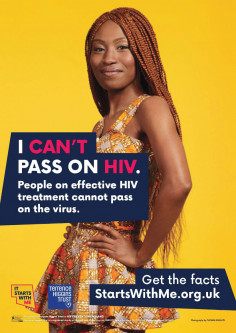Ask a group of people living with HIV, as I did recently, whether HIV stigma is better or worse than in the old days and mostly you will hear “the same” or even “worse.” Those answers arrive despite more than 30 years of trying, of anti-stigma campaigns, of personal testimonies, of HIV-positive celebrities coming out, of stigma-challenging T-shirts. Despite throwing the book at stigma for decades, our attempts to move the needle have been fruitless—or that’s the perception.
Whether that perception mirrors reality is moot. The evidence is skimpy. Thirty years in, we have tools to measure stigma—and we are starting to see them used, including here in Canada—but data is sparse. True, stigma is a challenging entity to measure even on a one-time basis, yet alone to track over decades. But if the prevailing wisdom is that we will not treat ourselves out of the epidemic and that stigma and its underpinnings need to be defeated to achieve victory, then we desperately need a battle plan, plus good measurement tools and sustained data collection.

A campaign from Toronto’s Centre for Addiction and Mental Health
In their absence we must rely on evidence that is empirical. It’s not necessarily reliable. If I say that as a privileged white gay man, HIV stigma is markedly less now than what I encountered over 25 years ago when I was first diagnosed, that statement can and should be challenged.
We in the HIV community continue to chip away at stigma, though, without really knowing how effective our efforts are. We are not alone. A billboard caught my eye in downtown Toronto. Its message: “WHY DO SOME ILLNESSES GET TREATMENT WHILE OTHERS GET JUDGEMENT?” It’s from a thoughtful campaign from Toronto’s Centre for Addiction and Mental Health (CAMH). “It’s time we said no more discrimination, no more ignorance, and no more funding gaps. It’s time for every Canadian to rally together to ensure mental illness gets the same priority as any other illness,” reads the message. But while the campaign’s objectives lean toward parity for people living with mental health, it also makes the point that values and judgment—and of course stigma—play an important role in health conditions way more numerous, in fact way more widespread, than HIV. “One in five Canadians experience mental illness in any given year. We all know someone” says the campaign’s website.
It’s not hard to identify other health conditions, besides mental health and HIV, that attract judgment, or blame or stigma of their own. Think addictions. Think smoking-related cancers, for example. Think sexually transmitted infections (STIs) of all stripes. The point is that campaigns that target stigma relating to any one illness inevitably invite comparisons. (There is some literature that compares the stigma associated with illness A to illness B but I’m not going there. The Stigma Olympics this is not.) The point is first that experiencing stigma is not at all rare in society, and secondly, that other disability groups are struggling to combat it too.
So what works?
I’ve often argued that the personal testimonies of people living with HIV are hugely important. They may not change societal views at anything but a snail’s pace, but they can and do change minds one at a time. Stigma, though, is so pervasive that, I’d wager, far more people work hard to hide their status than to share it with others. Relying on more people living with HIV to come out, because the challenges to doing so can be extreme, clearly isn’t enough. Meanwhile stigma is amplified by cruel comments on Facebook or dating websites. True our efforts are helped by newscasters who come out or movies that favourably portray HIV-positive characters, for example. On the other side of the coin, it’s also important to acknowledge that worthy efforts like these to eliminate stigma are also being diminished by negative publication around criminalization, the “HIV monster” narrative that has persisted for decades, and other unfriendly voices.

The Terrence Higgins Trust U=U campaignCoutesy of Terrence Higgins Trust
Some prevention campaigns haven’t helped us either. Certainly early shock campaigns designed to scare the public away from contracting HIV may have aided condom uptake but also scared people away from people living with HIV . Even discounting those ads designed to scare, it’s arguable whether the raft of anti-HIV stigma campaigns around the world has had any noticeable impact. (For some commentary on these go here.) Essentially we just don’t know. Evaluation in any meaningful way is largely missing.
I’m not arguing that that we should dissuade people from coming out and telling their stories and I’m not arguing we shouldn’t continue to mount broadly based anti-HIV stigma social media campaigns. Instead we need to be more effective.
The CAMH messaging I mentioned earlier is a values-based approach we have seldom really tried. Essentially it says we shouldn’t blame people for their illness. I like ethics that work. But with HIV, there is a more important factor we have to contend with. It’s the fear of transmission, a fear which service providers have inadvertantly engaged in amplifying for decades. That HIV is no longer what it was presents us with an opportunity to present a different narrative. True it involves normalizing HIV in a way that some have resisted but the public has to know what HIV looks like in 2019, not 1989. There is, of course, a huge difference.
The new face of HIV, although sadly not yet universal, is a healthy face. It’s a face on a body that lives as long as the next person. It’s a face that need not be feared. Why? If we are on successful treatment, we cannot transmit the virus to our sexual partners. These are facts we can prove. This information changes our lives but has the potential to change our place in society. We are no longer a threat. Voices that share that new reality are our most powerful weapon yet.
In other words, we have entered an era of science-based messaging. “Can’t pass it on” from Terrence Higgins Trust was an early example. The ubiquitous U=U from Prevention Access Campaign is another. Their uptake and influence has been massive—check out the current POZ cover story on U=U for more examples. Importantly the campaigns address the fear of HIV transmission that has clearly driven stigma, but the campaigns also speak to the health and well-being of people living with HIV. It’s a winning combination, and in 2019 it represents the best path forward to end stigma.

The March 2019 issue of POZ
More importantly, instead of throwing anything anti-stigma against the wall and hoping it sticks, we now have a tool with a much higher chance of success. The U=U message is incredibly powerful. It’s based on science, of course, but science that is easily simplified. It will take time to convince a hesitant populace that we no longer need be feared. We must at the same time be sensitive to the fact that we aren’t all undetectable, because of treatment access issues or adherence issues or choice. The largest challenges are still faced by the most marginalized. They need support, not further stigmatization. That being said, the opportunity to change the face of HIV is out there like never before. Ending HIV stigma is no longer a distant dream. It’s attainable.








4 Comments
4 Comments